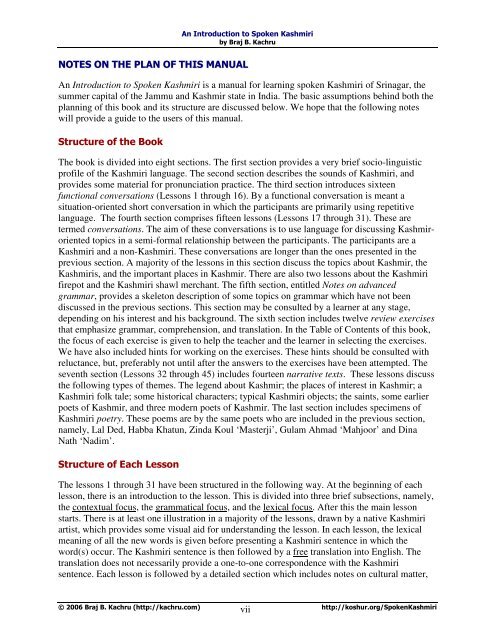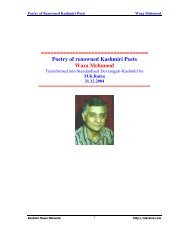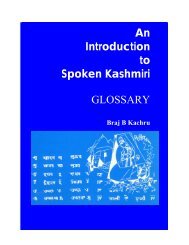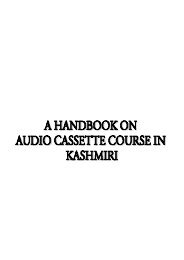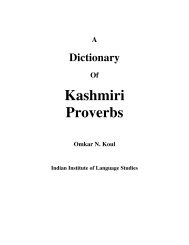Introductory Pages - An Introduction to Spoken Kashmiri
Introductory Pages - An Introduction to Spoken Kashmiri
Introductory Pages - An Introduction to Spoken Kashmiri
You also want an ePaper? Increase the reach of your titles
YUMPU automatically turns print PDFs into web optimized ePapers that Google loves.
<strong>An</strong> <strong>Introduction</strong> <strong>to</strong> <strong>Spoken</strong> <strong>Kashmiri</strong><br />
by Braj B. Kachru<br />
NOTES ON THE PLAN OF THIS MANUAL<br />
<strong>An</strong> <strong>Introduction</strong> <strong>to</strong> <strong>Spoken</strong> <strong>Kashmiri</strong> is a manual for learning spoken <strong>Kashmiri</strong> of Srinagar, the<br />
summer capital of the Jammu and Kashmir state in India. The basic assumptions behind both the<br />
planning of this book and its structure are discussed below. We hope that the following notes<br />
will provide a guide <strong>to</strong> the users of this manual.<br />
Structure of the Book<br />
The book is divided in<strong>to</strong> eight sections. The first section provides a very brief socio-linguistic<br />
profile of the <strong>Kashmiri</strong> language. The second section describes the sounds of <strong>Kashmiri</strong>, and<br />
provides some material for pronunciation practice. The third section introduces sixteen<br />
functional conversations (Lessons 1 through 16). By a functional conversation is meant a<br />
situation-oriented short conversation in which the participants are primarily using repetitive<br />
language. The fourth section comprises fifteen lessons (Lessons 17 through 31). These are<br />
termed conversations. The aim of these conversations is <strong>to</strong> use language for discussing Kashmiroriented<br />
<strong>to</strong>pics in a semi-formal relationship between the participants. The participants are a<br />
<strong>Kashmiri</strong> and a non-<strong>Kashmiri</strong>. These conversations are longer than the ones presented in the<br />
previous section. A majority of the lessons in this section discuss the <strong>to</strong>pics about Kashmir, the<br />
<strong>Kashmiri</strong>s, and the important places in Kashmir. There are also two lessons about the <strong>Kashmiri</strong><br />
firepot and the <strong>Kashmiri</strong> shawl merchant. The fifth section, entitled Notes on advanced<br />
grammar, provides a skele<strong>to</strong>n description of some <strong>to</strong>pics on grammar which have not been<br />
discussed in the previous sections. This section may be consulted by a learner at any stage,<br />
depending on his interest and his background. The sixth section includes twelve review exercises<br />
that emphasize grammar, comprehension, and translation. In the Table of Contents of this book,<br />
the focus of each exercise is given <strong>to</strong> help the teacher and the learner in selecting the exercises.<br />
We have also included hints for working on the exercises. These hints should be consulted with<br />
reluctance, but, preferably not until after the answers <strong>to</strong> the exercises have been attempted. The<br />
seventh section (Lessons 32 through 45) includes fourteen narrative texts. These lessons discuss<br />
the following types of themes. The legend about Kashmir; the places of interest in Kashmir; a<br />
<strong>Kashmiri</strong> folk tale; some his<strong>to</strong>rical characters; typical <strong>Kashmiri</strong> objects; the saints, some earlier<br />
poets of Kashmir, and three modern poets of Kashmir. The last section includes specimens of<br />
<strong>Kashmiri</strong> poetry. These poems are by the same poets who are included in the previous section,<br />
namely, Lal Ded, Habba Khatun, Zinda Koul ‘Masterji’, Gulam Ahmad ‘Mahjoor’ and Dina<br />
Nath ‘Nadim’.<br />
Structure of Each Lesson<br />
The lessons 1 through 31 have been structured in the following way. At the beginning of each<br />
lesson, there is an introduction <strong>to</strong> the lesson. This is divided in<strong>to</strong> three brief subsections, namely,<br />
the contextual focus, the grammatical focus, and the lexical focus. After this the main lesson<br />
starts. There is at least one illustration in a majority of the lessons, drawn by a native <strong>Kashmiri</strong><br />
artist, which provides some visual aid for understanding the lesson. In each lesson, the lexical<br />
meaning of all the new words is given before presenting a <strong>Kashmiri</strong> sentence in which the<br />
word(s) occur. The <strong>Kashmiri</strong> sentence is then followed by a free translation in<strong>to</strong> English. The<br />
translation does not necessarily provide a one-<strong>to</strong>-one correspondence with the <strong>Kashmiri</strong><br />
sentence. Each lesson is followed by a detailed section which includes notes on cultural matter,<br />
© 2006 Braj B. Kachru (http://kachru.com) vii<br />
http://koshur.org/<strong>Spoken</strong><strong>Kashmiri</strong>


